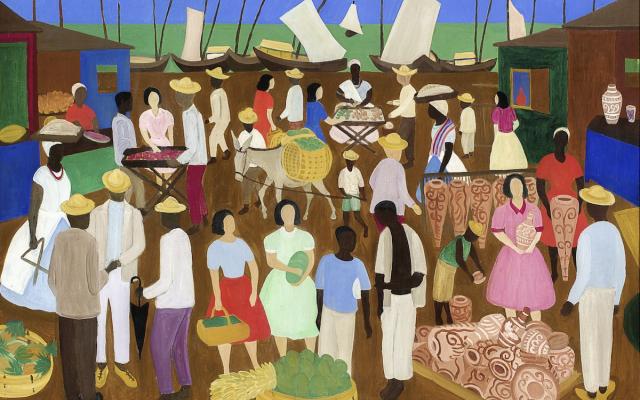Gente Serpiente (Serpent People)
2019 - Sculpture (Sculpture)
71 x 35 x 24 cm
Mazenett Quiroga
Gente Serpiente (Serpent People) is a piece made with the wheels of bikes, twisted, intertwined and painted like skins of tropical poisonous snakes. This sculpture, as well as other pieces by Mazenett and Quiroga, seeks to reveal and re-inscribe everyday and ordinary objects within a mythological tradition, to reconnect them with an origin in order to recognize their hidden life and meaning. These objects represent the life cycle and the animal, as well as cultural and geological time: long ago they were marine organisms and through the action of sand, sediment and mud, in oil, then in wheels they are transformed. Painted like snakes they recall the symbol of the eternal return, they refer to transformations that go beyond the obsolete distinction between natural and cultural objects.
Mazenett Quiroga have been working collaboratively in Bogotá, Colombia for the past nine years. In their projects, they explore the interrelationship between organisms and the misnamed “resources” of our environment and how these relationships are appropriated and distributed by means of culture. They reflect on temporality, origin, and symbolism of fundamental elements of the world economy, working with materials of fossil origin, such as tar, pitch, coal and a diversity of minerals. Omnipresent in our daily lives, minerals connect humans with remote geological times. The artists’ practice is informed by a close dialogue between mythology from Amazonian peoples and western science such as geology, astronomy, and economy, trying to reconnect ordinary and everyday elements with ancient knowledge and mythical time.
Colors:
Related works sharing similar palette

© » KADIST
Olivia Erlanger
2016Sideways Time by Olivia Erlanger is the result of the artist’s interest in networks, seen and unseen, financial and ecological, the collapse of which has resulted in the fracturing of a middle class American identity...

© » KADIST
Gimhongsok
2007To explore the boundaries between artwork and audience, Gimhongsok created a series of sculptural performances in which a person wearing an animal costume poses in the gallery...

© » ARTS EQUATOR
Careening Into “The Milk of Dreams”: Southeast Asia at the 59th Venice Biennale | ArtsEquator Skip to content While the stated theme of the Biennale is to challenge the hegemony of the West, Nicole Wong finds that the spaces created for these interventions to happen struggles against the behemoth of the Biennale itself...

© » ART & OBJECT
10 Exhibitions to See During Black History Month | Art & Object Skip to main content Subscribe to our free e-letter! Webform Your Email Address Role Art Collector/Enthusiast Artist Art World Professional Academic Country USA Afghanistan Albania Algeria American Samoa Andorra Angola Anguilla Antarctica Antigua & Barbuda Argentina Armenia Aruba Ascension Island Australia Austria Azerbaijan Bahamas Bahrain Bangladesh Barbados Belarus Belgium Belize Benin Bermuda Bhutan Bolivia Bosnia & Herzegovina Botswana Bouvet Island Brazil British Indian Ocean Territory British Virgin Islands Brunei Bulgaria Burkina Faso Burundi Cambodia Cameroon Canada Canary Islands Cape Verde Caribbean Netherlands Cayman Islands Central African Republic Ceuta & Melilla Chad Chile China Christmas Island Clipperton Island Cocos (Keeling) Islands Colombia Comoros Congo - Brazzaville Congo - Kinshasa Cook Islands Costa Rica Croatia Cuba Curaçao Cyprus Czechia Côte d’Ivoire Denmark Diego Garcia Djibouti Dominica Dominican Republic Ecuador Egypt El Salvador Equatorial Guinea Eritrea Estonia Eswatini Ethiopia Falkland Islands Faroe Islands Fiji Finland France French Guiana French Polynesia French Southern Territories Gabon Gambia Georgia Germany Ghana Gibraltar Greece Greenland Grenada Guadeloupe Guam Guatemala Guernsey Guinea Guinea-Bissau Guyana Haiti Heard & McDonald Islands Honduras Hong Kong SAR China Hungary Iceland India Indonesia Iran Iraq Ireland Isle of Man Israel Italy Jamaica Japan Jersey Jordan Kazakhstan Kenya Kiribati Kosovo Kuwait Kyrgyzstan Laos Latvia Lebanon Lesotho Liberia Libya Liechtenstein Lithuania Luxembourg Macao SAR China Madagascar Malawi Malaysia Maldives Mali Malta Marshall Islands Martinique Mauritania Mauritius Mayotte Mexico Micronesia Moldova Monaco Mongolia Montenegro Montserrat Morocco Mozambique Myanmar (Burma) Namibia Nauru Nepal Netherlands Netherlands Antilles New Caledonia New Zealand Nicaragua Niger Nigeria Niue Norfolk Island Northern Mariana Islands North Korea North Macedonia Norway Oman Outlying Oceania Pakistan Palau Palestinian Territories Panama Papua New Guinea Paraguay Peru Philippines Pitcairn Islands Poland Portugal Puerto Rico Qatar Romania Russia Rwanda Réunion Samoa San Marino Saudi Arabia Senegal Serbia Seychelles Sierra Leone Singapore Sint Maarten Slovakia Slovenia Solomon Islands Somalia South Africa South Georgia & South Sandwich Islands South Korea South Sudan Spain Sri Lanka St...

© » KADIST
Santiago Yahuarcani
2017The series Castigos del caucho by Santiago Yahuarcani originates in the oral memory transmitted by the artist’s grandfather, who was a survivor of the Putumayo genocide where thousands of Indigenous people were annihilated and enslaved to extract rubber from the Amazon forest between 1879 and 1912...

© » KADIST
Rahima Gambo
2020“ I think we are oversaturated, filled to the brim with images in our inner subconscious eye...

© » KADIST
Carolina Caycedo
2014YUMA o la tierra de los amigos (YUMA, or the Land of Friends) by Carolina Caycedo is a large mural containing a series of satellite photographs mounted on acrylic...

© » KADIST
Alicia Smith
2018The title of Alicia Smith’s video work, Teomama , means “God Carrier” in the Aztec language of Nahuatl...

© » ARTS EQUATOR
The Commission: Why do these three meet again? | ArtsEquator Thinking and Talking about Arts and Culture in Southeast Asia ArtsEquator Viewpoints Crispian Chan June 28, 2021 By Eugene Tan (1,503 words, 5-minute read) As has become customary for every review of a Singapore International Festival of the Arts (SIFA) 2021 show (or as the festival programme now calls them, “content”), we should applaud the fact that these shows are happening at all...











